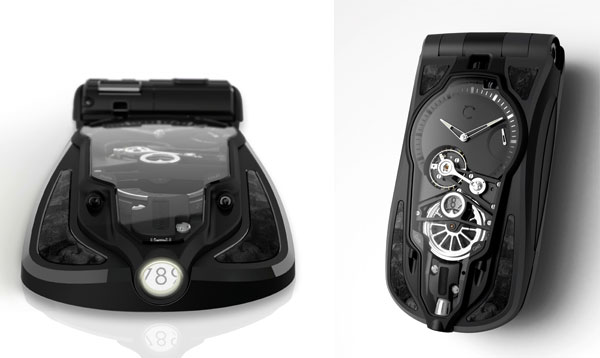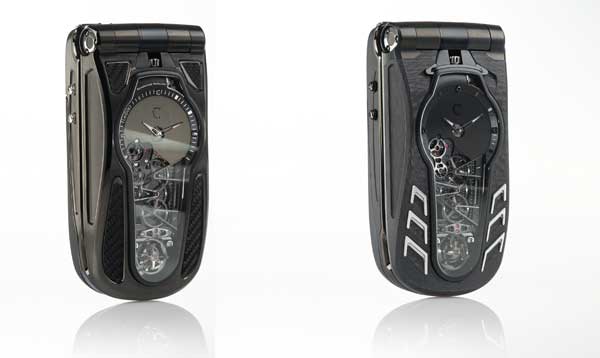OptiC GMT Furtif
Case : PVD-coated grade 5 titanium with carbon fibre and quartz fibre inserts Dimensions : 100 x 49 x 28mm Movement : mechanical self-winding (conceived by Celsius X VI II and developed by Chronode and MFM), 324 parts, high-end watchmaking finishes Functions : hours, minutes, 42-hour power-reserve display, date and second time zone by optical fibre technology, watch movement wound by clamshell phone opening Telecommunications platform : 2.75 G –GSM-GPRS-EDGE: Triband 900/1800/1900MHz Accessories : hands-free kit with mechanical parts and personalised leather holster Limited series : 28
First unveiled in this magazine in the spring of 2011, the famous Remontage Papillon equipping the first mechanical mobile phone with a flying tourbillon has chosen the autumn of this year to make its latest appearance on the new nomadic object from Celsius X VI II: the
OptiC GMT Furtif with its mysterious optical double display. Of the 700 mechanical parts composing this compendium of sophisticated technologies housed within lines evoking aviation or F1 motor-racing, 324 are dedicated to its watch movement created in cooperation with Chronode and MFM. Combined with an unusual index assembly, this exclusive calibre with its visible regulating organ is distinguished by its world-first dual display: the hours indicate the hours, the minutes and the 42-hour power reserve, while the second time zone and the date appear as if by magic thanks to fibre optic microguide technology. While the first is read off “normally” beneath the hours in the centre, the second time zone is even more surprising because of its position at the far end of the object on the edge of the hinged cover. The numerals are in fact inscribed on a cylinder rotating inside the mechanism, linked to the aperture by animated optical fibres of the revolutionary endoscopic “Image Guiding System”. As on previous models, each opening or closing of the clamshell phone drives the Remontage Papillon system housed in the hinge and supplies the movement with an additional two hours’ autonomy.
The world of Fine Watchmaking pervades every inch of this ultra-innovative creation, of which the PVD-coated grade 5 titanium structure has been entirely machined from the block, and then enriched with carbon fibre and quartz fibre inserts, before being treated to hand-crafted Clous de Paris, shotblasted, polished and satin-brushed decorative finishes. The Clous de Paris hobnailed pattern also appears on the micromechanical battery-ejection system (with its 240-hour autonomy in standby mode). The phone’s user-friendly interface is based on Triband technology which is one of the most reliable on the market. A clever ecosystem of original leather and metal accessories complements this melodious and desirable limited series, that is also more accessible than the first generation and exclusively available in Switzerland at Les Ambassadeurs boutiques.







